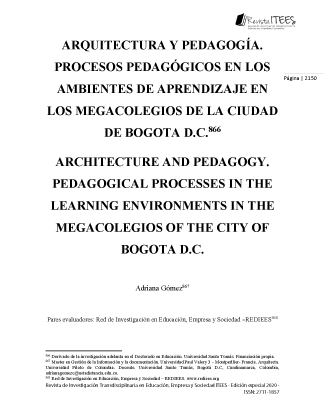CXII. ARCHITECTURE AND PEDAGOGY. PEDAGOGICAL PROCESSES IN THE LEARNING ENVIRONMENTS IN THE MEGACOLEGIOS OF THE CITY OF BOGOTA D.C.
##plugins.themes.bootstrap3.article.main##
Abstract
Society has always considered how transcendental education is at all levels, for this reason
men and women have offered their knowledge to build the educational being; and the State
has established public policies for its growth, development, updating and expansion, among
others. Likewise, in society, school buildings have been designed so that educational systems
are developed according to pedagogical models, adjusted to organizational indicators (time
and space).
This research was developed in the doctorate in Education in the line of Pedagogy and
didactics of the Santo Tomás University, whose main purpose is to identify the pedagogical
processes in the learning environments of the mega colleges of the city of Bogotá D.C. These
are those schools of great capacity and large structures equipped with various locative
resources such as laboratories, restaurants, libraries, among others that seek that the spaces
created not only facilitate pedagogical processes, but also offer favorable environments for
the comprehensive training of students (More and better schools - SED, 2009). The research
is framed in a qualitative-interpretive approach applying an educational ethnographic design
because it aims to access school environments to know the learning environments from the
experience and meanings of students, teachers, and managers, and determine how the
pedagogical processes there These facts affect the integral formation of students.
Download Statistics
##plugins.themes.bootstrap3.article.details##
education sciences, architecture, learning
Ediciones Morata.
Bayona, H. (2016). "Efectos de la infraestructura sobre el fracaso escolar: evidencia empírica
para Colombia". Voces y Silencios. Revista Latinoamericana de Educación 7, N
o
2:
19-40. https://doi.org/10.18175/vys7.2.2016.03
García, D. (2019). La cartografía educativa como método cualitativo para comprender el
currículo.
Heras, L. (1997). Comprender el espacio educativo. Investigación etnográfica sobre un
centro escolar. Ediciones ALJIBE.
Hernando, A. (2015). Viaje a la escuela del s. XXI. Así trabajan los colegios más innovadores
del mundo. Fundación telefónica
Pozo Bernal, M. (2014, junio). Arquitectura y Pedagogía: La disolución del aula: mapa de
espacios arquitectónicos para un territorio pedagógico. International Conference
Arquitectonics Network: Architecture, Education and Society, Barcelona, 4-6 June
2014: Final papers. https://upcommons.upc.edu/handle/2117/114942
Secretaria de Educación. (2009). Más y mejores colegios para Bogotá.
http://repositoriosed.educacionbogota.edu.co/handle/001/1643
Rodríguez, A. (2020). Desarrollo cognitivo en adolescencia: Características, cambios
cognitivos. https://www.lifeder.com/desarrollo-cognitivo-adolescencia/





